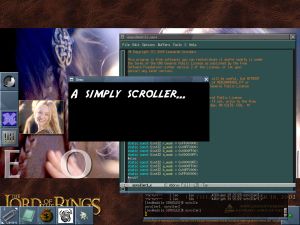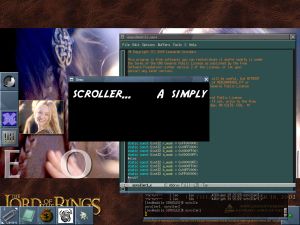|
|
![[Leonardo]](../../common/images/LeonardoGiordani.jpg)
by Leonardo Giordani <leo.giordani(at)libero.it> About the author: I just received my diploma from the Faculty of Telecommunication Engineering in Politecnico of Milan. Interested in programming (mostly in Assembly and C/C++). Since 1999 works almost only with Linux/Unix. Translated to English by: Leonardo Giordani <leo.giordani(at)libero.it> |
Implementing a scroller in SDL graphics![[sdl]](../../common/images/illustration288.jpg)
Abstract: This series of articles has the purpose of introducing the reader to the world of multimedia productions, also known as "demos". The whole Internet is full of informations about the matter, but few people does write such beautiful thing for Linux: my goal is to describe the theory of some graphical and sound effects and their implementation using the SDL library. Further informations can be found at
Prerequisites for the understanding of the article are:
|
A scroller is a part of a demo that write a moving sentence on the screen: it is one of the basic effect that you can find in a multimedia production and adds a bit of dynamicity to the text you want show to the user. In this article we will see how to build a basic scroller that moves the text from right to left.
The basic idea of a scroller is to copy a part of of the screen one or more pixel to the left (or to some direction). Executing this operation with a good speed you obtain the illusion of a continuous movement, and that's all.
The basic theory is not very complex; let's see how to translete all this in code terms: we will refer from now on to the concept of surface, well known to those who have some basic SDL programming skills. Working with the SDL library we have always to remember that we can use the powerful
SDL_BlitSurface() function, which let us copy part of an SDL_Surface identified by an SDL_Rect on another SDL_Surface identified by another SDL_Rect .For example, imagine we defined and initialized two surfaces and two rectangles
#define WIDTH 800
#define HEIGHT 600
SDL_Surface *Src;
SDL_Surface *Dst;
Src = SDL_CreateRGBSurface(SDL_HWSURFACE, WIDTH, HEIGHT, 8,
r_mask, g_mask, b_mask, a_mask);
Dst = SDL_CreateRGBSurface(SDL_HWSURFACE, WIDTH, HEIGHT, 8,
r_mask, g_mask, b_mask, a_mask);
SDL_Rect BigArea = {0, 0, (WIDTH / 2), HEIGHT};
SDL_Rect SmallArea = {(WIDTH / 2) + 1, 0, (WIDTH / 2), (HEIGHT / 2)};
where we supposed the color mask to be already well
initialized. Copying the two full surfaces implies a minimal
effort
SDL_BlitSurface(Src, 0, Dst, 0);Note that on the destiantion surface only the origin coordinates of the rectangle are considered and not the dimension: this means that the operation
SDL_BlitSurface(Src, &BigArea, Dst, &SmallArea);is perfectly legal and copies the left half of the Src surface on the right half of the Dst surface.
Now performing the scroll of a surface should no more be a mistery: it is sufficient copying a part of the surface in a shifted rectangle on the same surface; clearly all this code have to be but in a loop, so the resulting program becomes a bit more complex, but the basic concept is simple. At every tick of the loop we use two rectangles, the second shifted respects to the first in the direction of the scrolling, and we copy the surface on itself from the first to the second rectangle.
SDL_Surface *temp;
SDL_Rect From = {1, 0, WIDTH, HEIGHT};
SDL_Rect First = {0, 0, 1, HEIGHT};
SDL_Rect Last = {WIDTH-1, 0, 1, HEIGHT};
temp = SDL_CreateRGBSurface(SDL_HWSURFACE, 1, HEIGHT, 8,
r_mask, g_mask, b_mask, a_mask);
while(1){
SDL_BlitSurface(Src, &First, temp, 0);
SDL_BlitSurface(Src, &From, Src, 0);
SDL_BlitSurface(temp, &First, Src, &Last);
SDL_BlitSurface(Src, 0, Screen, 0);
}
As you can see, it is not sufficient to scroll the surface
towards left: we have to reinsert from the right the pixels
exited from the screen, or the scrolling surface will let
behind itself the copies of the last column, generating a sort
of "dragging" effect. We supposed to have already a surface
linked to the screen. Now let's see a complete program that
opens a 480x200 window and performs the continuous scolling of
an image on it.
#include "SDL/SDL.h" #include "SDL/SDL_image.h" #define SCREEN_WIDTH 480 #define SCREEN_HEIGHT 200 #if SDL_BYTEORDER == SDL_BIG_ENDIAN static const Uint32 r_mask = 0xFF000000; static const Uint32 g_mask = 0x00FF0000; static const Uint32 b_mask = 0x0000FF00; static const Uint32 a_mask = 0x000000FF; #else static const Uint32 r_mask = 0x000000FF; static const Uint32 g_mask = 0x0000FF00; static const Uint32 b_mask = 0x00FF0000; static const Uint32 a_mask = 0xFF000000; #endifThis set of definitions is standard in (almost) every multimedia production.
static SDL_Surface* img_surface; static SDL_Surface* scroll_surface; static SDL_Surface* temp_surface;These are the three surface we will use: img_surface will contain the image loaded from file, scroll_surface the shifted image and temp_surface the pixels we have to let enter again from right.
static const SDL_VideoInfo* info = 0; SDL_Surface* screen;A SDL_VideoInfo structure contains informations about video hardware, while the screen surface will point to the real screen.
int init_video()
{
if( SDL_Init( SDL_INIT_VIDEO) < 0 )
{
fprintf( stderr, "Video initialization failed: %s\n",
SDL_GetError( ) );
return 0;
}
info = SDL_GetVideoInfo( );
if( !info ) {
fprintf( stderr, "Video query failed: %s\n",
SDL_GetError( ) );
return 0;
}
return 1;
}
int set_video( Uint16 width, Uint16 height, int bpp, int flags)
{
if (init_video())
{
if((screen = SDL_SetVideoMode(width,height,bpp,flags))==0)
{
fprintf( stderr, "Video mode set failed: %s\n",
SDL_GetError( ) );
return 0;
}
}
return 1;
}
The
init_video()
function initializes the SDL video subsystem and fills up the
info
structure. The
set_video()
function tries to set a given video mode (dimensions and color
depth).
void quit( int code )
{
SDL_FreeSurface(scroll_surface);
SDL_FreeSurface(img_surface);
SDL_Quit( );
exit( code );
}
This is the essential termination function, which deallocates
all the resources we used and calls
SDL_Quit
.
void handle_key_down( SDL_keysym* keysym )
{
switch( keysym->sym )
{
case SDLK_ESCAPE:
quit( 0 );
break;
default:
break;
}
}
A "key pressed" event: in this case the ESC key.
void process_events( void )
{
SDL_Event event;
while( SDL_PollEvent( &event ) ) {
switch( event.type ) {
case SDL_KEYDOWN:
handle_key_down( &event.key.keysym );
break;
case SDL_QUIT:
quit( 0 );
break;
}
}
}
The not lesser essential event management function.
void init()
{
SDL_Surface* tmp;
Uint16 i;
tmp = SDL_CreateRGBSurface(SDL_HWSURFACE, SCREEN_WIDTH,
SCREEN_HEIGHT, 8, r_mask, g_mask, b_mask, a_mask);
scroll_surface = SDL_DisplayFormat(tmp);
SDL_FreeSurface(tmp);
Let's work with a
tmp
surface to initialize
scroll_surface
and
temp_surface
. Both are converted in the video framebuffer format through
the
SDL_DisplayFormat
function.
img_surface = IMG_Load("img.pcx");
Here we load into img_surface the image saved in the file.
for (i = 0; i < SDL_NUMEVENTS; ++i)
{
if (i != SDL_KEYDOWN && i != SDL_QUIT)
{
SDL_EventState(i, SDL_IGNORE);
}
}
SDL_ShowCursor(SDL_DISABLE);
}
All events are ignored except for the pressure of a key and the
exit from the program; moreover we disable the cursor.
int main( int argc, char* argv[] )
{
SDL_Rect ScrollFrom = {1, 0, SCREEN_WIDTH, SCREEN_HEIGHT};
SDL_Rect First = {0, 0, 1, SCREEN_HEIGHT};
SDL_Rect Last = {SCREEN_WIDTH - 1, 0, 1, SCREEN_HEIGHT};
These are the three rectangles described in the article.
if (!set_video(SCREEN_WIDTH, SCREEN_HEIGHT, 8,
SDL_HWSURFACE | SDL_HWACCEL | SDL_HWPALETTE /*| SDL_FULLSCREEN*/))
quit(1);
SDL_WM_SetCaption("Demo", "");
init();
SDL_BlitSurface(img_surface, 0, scroll_surface, 0);
This code initializes the whole thing: set the video mode,
writes the window title, calls
init()
and prepares
scroll_surface
.
while( 1 )
{
process_events();
SDL_BlitSurface(scroll_surface, &First, temp_surface, 0);
SDL_BlitSurface(scroll_surface, &ScrollFrom, scroll_surface, 0);
SDL_BlitSurface(temp_surface, &First, scroll_surface, &Last);
SDL_BlitSurface(scroll_surface, 0, screen, 0);
SDL_Flip(screen);
}
return 0;
}
This is the loop described in the article: only the event
control functions and the screen surface flip have been added.
As you can see the initialization work for the library is not short, but with the advantage that it is common to the whole demo, so while the code increases, initialization will become even more a small part of the full program, and it is a reusable and portable one.


ps: You can send me comments, corrections and questions at my mail address or through the Talkback page. Plese write me in english, german or italian.
|
Webpages maintained by the LinuxFocus Editor team
© Leonardo Giordani "some rights reserved" see linuxfocus.org/license/ http://www.LinuxFocus.org |
Translation information:
|
2005-01-14, generated by lfparser_pdf version 2.51